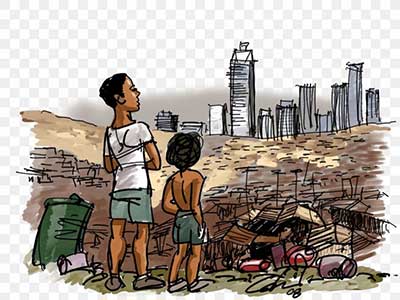Relevance: GS-2: Issues relating to poverty and hunger
Key Phrases: The Right to Food Campaign, Hunger Watch survey, National Rural Employment Guarantee Act, Minimum wages, IMF, World Bank.
Context
- COVID-19 has upended Indian society. Over two-thirds of the country has been infected by COVID-19 and perhaps five million or so people have died, directly or indirectly, from the pandemic.
Background
- Two years ago, the imposition of the national lockdown in India had disastrous consequences for the working poor, especially the migrant labour.
- In October 2020, The Right to Food Campaign and associated organisations had conducted the first Hunger Watch survey (HW-I).
- The main objective of HW-I was to document the economic distress and hunger caused by the lockdowns and catalyse public action for relief.
- Covering close to 4,000 people in 11 states, the survey highlighted the extent of widespread hunger and a deterioration in the quality of diets compared to the pre-pandemic period.
- In 2021, India was hit by a devastating second wave of infections.
- While no nationwide lockdowns were announced, the speed and severity of the spread meant inevitable disruptions to lives and livelihoods. Most states imposed curfews and restrictions on economic activity.
Right to Food Campaign
- The Right To Food Campaign is an informal network of individuals and organisations committed to the realisation of the right to food in India.
- The campaign began in 2001 as an offshoot of public interest litigation in the Supreme Court, and quickly grew into a country-wide movement.
- The campaign, which has taken up a wide range of aspects of the right to food, has several demands and some of these have already been met to some extent.
- Among these are the passage of the National Rural Employment Guarantee Act of 2005 and National Food Security Act of 2013, and the introduction of cooked mid-day meals in all primary schools following a Supreme Court order in April 2004.
Income Inequality
- In 2019, the average monthly income of households in the top 25% and bottom 25% of the income distribution was approximately ₹45,000 and ₹8,000, respectively, in urban areas, and ₹22,500 and ₹7,500, respectively, in rural areas.
- While the average monthly income of the top quartile in urban areas fell almost 30%, to ₹32,500 by July 2021, the monthly income of the bottom quartile in July 2021 remained at pre-pandemic levels.
- In rural areas, the top quartile income fell by perhaps 20%, while the bottom quartile income grew slightly during the same period.
- The result is that inequality, measured as the percentage change in the income of the top quartile minus the income in the bottom quartile, fell by 15-20 percentage points.
- This is a robust finding: richer households saw larger drops in income all along the income scale, in rural and urban areas, within each State, and even within caste groups.

Demand for labour
- The better explanation for the disproportionate loss of labour income among the top quartile households is that demand for their labour fell more.
- The rich tend to work in the service sector, and demand for services fell more than demand for other sectors.
- While 30% of workers in bottom quartile households work in the service sector, 45% of workers from the top quartile households do.
- During the pandemic, consumer spending on services fell by 30%-40%, far more than the decline in spending on manufacturing or agriculture.
- The situation was reversed in manufacturing. That sector employs a larger share of bottom quartile workers than top quartile ones: 35% versus 15%.
- But manufacturing declined less than 20% during the pandemic. The progressive contraction of demand for services swamped the regressive contraction of demand for manufacturing.
Ways To Tackle Income Inequality In India
- Solutions to reducing income inequality lie in three aspects:
- Investing in women:
- Investing in women as important workers is necessary and urgent today to reduce inequality and increase nations’ gross domestic product (GDP).
- As IMF Chief said, if women’s participation in the workforce matched men’s, Japan could grow at 9 per cent per annum and India at 27 per cent.
- Investing in agriculture:
- As per the World Bank, agriculture can help reduce poverty for 80 per cent of the world’s poor who live in rural areas and work mainly in farming.
- Reforming workplace laws:
- Reforms in workers’ laws can reduce inequalities. Minimum wages and universal basic income (UBI) are two of the popular ways to reform workplace laws.
- They both have the same aim — raising incomes of the least fortunate to reduce the income gap. These are imposed by law and paid by the employer.
- Investing in women:
Conclusion
- The loss of life and rise in poverty make it one of the larger disasters the country has borne.
- The reduction in inequality would be a silver lining if it were accomplished by lowering poverty rather than reducing the income of the rich.
- Nevertheless, by understanding the decline in inequality during the pandemic we can assess prospects for inequality after it ends.
- Once demand for services rises, along with aggregate income, both demand for the labour of the rich and the business income of that group will likely return. There is a risk that inequality will return to pre-pandemic levels.
Sources: The Hindu Indian Express
Mains Questions:
Q. There are signs that this pandemic has not followed the usual script- of the poor bearing the brunt of the pain. Critically examine the statement (words 250).









